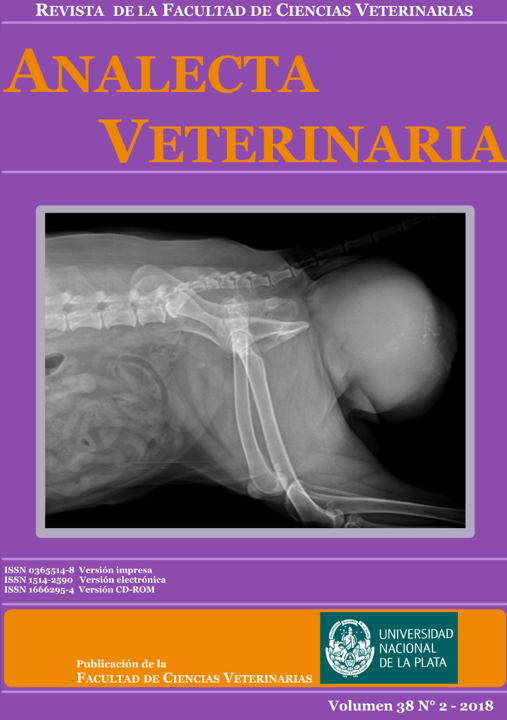Isolation of serovars of Salmonella enterica from feces of domestic and wild animals in captivity
DOI:
https://doi.org/10.24215/15142590e028Keywords:
Salmonella, zoo, serovars, zoonosesAbstract
Fecal samples corresponding to 27 species of animals in captivity in the Mendoza Zoo (Argentina) were collected, in order to find asymptomatic carriers of Salmonella. The fecal samples obtained with swabs were seeded in Müller-Kauffmann base tetrathionate and incubated at 43 °C in a water bath for 24 h. Then, aliquots of this medium were seeded on xylose-lysine-deoxycholate agar and, finally, formed colonies were identified using conventional biochemical tests. As a result, Salmonella serovar Meleagridis was isolated from a polar bear and Salmonella serovar Give from a brown bear and a carayá monkey samples. Both serovars are associated with cases of salmonellosis in humans.
Downloads
Metrics
References
Caffer MI, Terragno, R. 2001. Manual de procedimientos para la caracterización de Salmonella. Disponible en: https://docplayer.es/12601568-Manual-de-procedimientos-para-la-caracterizacion-de-salmonella.html (consultado 05/04/ 2018)
Eng SK, Pusparajah P, Ab Mutalib NS, Ser HL, Chan KG & Lee LH. 2015. Salmonella: A review on pathogenesis, epidemiology and antibiotic resistance. Frontiers in Life Science. 8(3):284-93. doi: 10.1080/21553769.2015.1051243
Girardin F, Mezger N, Hächler H, Bovier PA. 2006. Salmonella serovar Give: An unusual pathogen causing splenic abscess. European Journal of Clinical Microbiology Infectious Diseases. 25:272-4. doi: 10.1007/s10096-006-0122-2
Higgins R, Desilets A, Cantin M, Messier S, Khakhria R, Ismail J, Mulvey MR, Daignault D, Caron H. 1997. Outbreak of Salmonella Give in the province of Quebec. Canadian Veterinary Journal. 38:780-1.
Lima DCV, Siqueira DB, Mota RA, Rameh-de-Albuquerque LC, Souza SD, Santos AS, Silva LBG. 2012. Microbiologia de swabs retais e otológicos em carnívoros silvestres do zoológico do Parque Estadual de Dois Irmãos, Pernambuco. Pesquisa Veterinária Brasileira. 32(2):159-64.
Manual Oxoid. 2006. 9th Edition. Basingstoke (Inglaterra), Oxoid Limited.
Noseda RP, Bigalli MC, Andrich MG, Cordeviola JM. Bardón JC, Martínez AH, Combessies GM. 2002. Aislamiento de Salmonella en muestras clínicas humanas, animales y alimentos, durante 1988-2001. Veterinaria Argentina. 19:752-9.
Silva-Hidalgo G, López-Moreno HS, Ortiz-Navarrete VF, Alpuche-Aranda C, Rendón-Maldonado JG, López-Valenzuela
JA, López-Valenzuela M, Juárez-Barranco F. 2013. Prevalence of Salmonella enterica serovar Albany in captive zoo wild animals in the Culiacán Zoo in Mexico. Journal of Zoo and Wildlife Medicine. 44(1):8-14. doi: 10.1638/1042-7260-44.1.8
Zaidi MB, McDermott PF, Fedorka-Cray P, Leon V, Canche C, Hubert SK, Abbott J, León Zhao S, Headrick M, Tollefson L. 2006. Nontyphoidal Salmonella from human clinical cases, asymptomatic children, and raw retail meats in
Yucatan, México. Clinical infectious diseases. 1:42(1):21-8. doi: 10.1086/498508
Downloads
Published
How to Cite
Issue
Section
License
Authors retain the copyright and assign to the journal the right of the first publication, with the with the terms of the Creative Commons attribution license. This type of license allows other people to download the work and share it, as long as credit is granted for the authorship, but does not allow them to be changed in any way or used them commercially.

Analecta Veterinaria by School of Veterinary Sciences, National University of La Plata is distributed under a Creative Commons Attribution-NonCommercial-NoDeriv 4.0 International License.

























